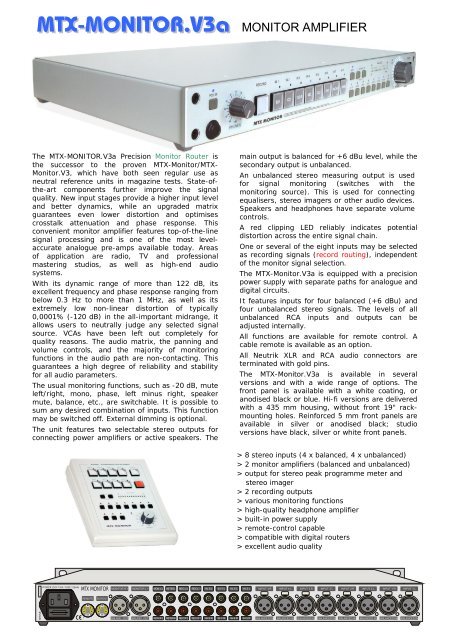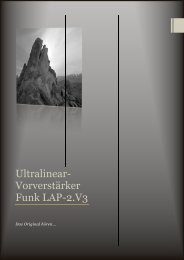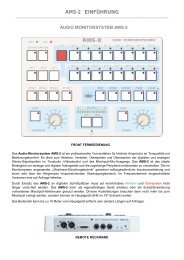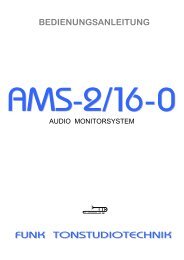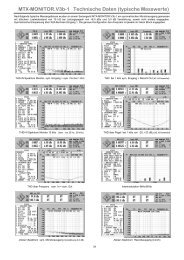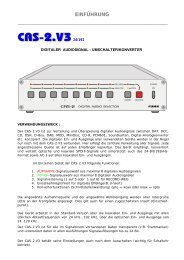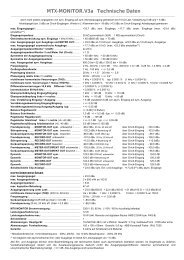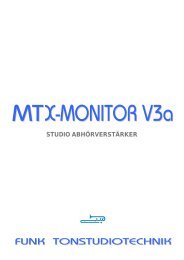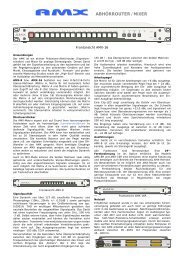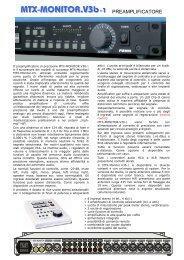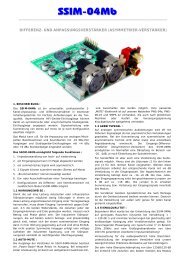MONITOR AMPLIFIER - Funk Tonstudiotechnik
MONITOR AMPLIFIER - Funk Tonstudiotechnik
MONITOR AMPLIFIER - Funk Tonstudiotechnik
You also want an ePaper? Increase the reach of your titles
YUMPU automatically turns print PDFs into web optimized ePapers that Google loves.
The MTX-<strong>MONITOR</strong>.V3a Precision Monitor Router is<br />
the successor to the proven MTX-Monitor/MTX-<br />
Monitor.V3, which have both seen regular use as<br />
neutral reference units in magazine tests. State-ofthe-art<br />
components further improve the signal<br />
quality. New input stages provide a higher input level<br />
and better dynamics, while an upgraded matrix<br />
guarantees even lower distortion and optimises<br />
crosstalk attenuation and phase response. This<br />
convenient monitor amplifier features top-of-the-line<br />
signal processing and is one of the most levelaccurate<br />
analogue pre-amps available today. Areas<br />
of application are radio, TV and professional<br />
mastering studios, as well as high-end audio<br />
systems.<br />
With its dynamic range of more than 122 dB, its<br />
excellent frequency and phase response ranging from<br />
below 0.3 Hz to more than 1 MHz, as well as its<br />
extremely low non-linear distortion of typically<br />
0,0001% (-120 dB) in the all-important midrange, it<br />
allows users to neutrally judge any selected signal<br />
source. VCAs have been left out completely for<br />
quality reasons. The audio matrix, the panning and<br />
volume controls, and the majority of monitoring<br />
functions in the audio path are non-contacting. This<br />
guarantees a high degree of reliability and stability<br />
for all audio parameters.<br />
The usual monitoring functions, such as -20 dB, mute<br />
left/right, mono, phase, left minus right, speaker<br />
mute, balance, etc., are switchable. It is possible to<br />
sum any desired combination of inputs. This function<br />
may be switched off. External dimming is optional.<br />
The unit features two selectable stereo outputs for<br />
connecting power amplifiers or active speakers. The<br />
SER.NR.<br />
POWER 230V 15VA<br />
FUSE 125mAt MTX <strong>MONITOR</strong><br />
REMOTE<br />
DIG.ROUT<br />
<strong>MONITOR</strong> R 1<br />
BALANC. OUT<br />
<strong>MONITOR</strong> L 1<br />
BALANC. OUT<br />
MON.L 2 METER L REC.L 2 REC.L 1<br />
IN 8 L<br />
IN 7 L<br />
IN 6 L<br />
<strong>MONITOR</strong> <strong>AMPLIFIER</strong><br />
main output is balanced for +6 dBu level, while the<br />
secondary output is unbalanced.<br />
An unbalanced stereo measuring output is used<br />
for signal monitoring (switches with the<br />
monitoring source). This is used for connecting<br />
equalisers, stereo imagers or other audio devices.<br />
Speakers and headphones have separate volume<br />
controls.<br />
A red clipping LED reliably indicates potential<br />
distortion across the entire signal chain.<br />
One or several of the eight inputs may be selected<br />
as recording signals (record routing), independent<br />
of the monitor signal selection.<br />
The MTX-Monitor.V3a is equipped with a precision<br />
power supply with separate paths for analogue and<br />
digital circuits.<br />
It features inputs for four balanced (+6 dBu) and<br />
four unbalanced stereo signals. The levels of all<br />
unbalanced RCA inputs and outputs can be<br />
adjusted internally.<br />
All functions are available for remote control. A<br />
cable remote is available as an option.<br />
All Neutrik XLR and RCA audio connectors are<br />
terminated with gold pins.<br />
The MTX-Monitor.V3a is available in several<br />
versions and with a wide range of options. The<br />
front panel is available with a white coating, or<br />
anodised black or blue. Hi-fi versions are delivered<br />
with a 435 mm housing, without front 19" rackmounting<br />
holes. Reinforced 5 mm front panels are<br />
available in silver or anodised black; studio<br />
versions have black, silver or white front panels.<br />
> 8 stereo inputs (4 x balanced, 4 x unbalanced)<br />
> 2 monitor amplifiers (balanced and unbalanced)<br />
> output for stereo peak programme meter and<br />
stereo imager<br />
> 2 recording outputs<br />
> various monitoring functions<br />
> high-quality headphone amplifier<br />
> built-in power supply<br />
> remote-control capable<br />
> compatible with digital routers<br />
> excellent audio quality<br />
IN 5 L<br />
INPUT 4 R<br />
INPUT 4 L<br />
INPUT 3 R<br />
INPUT 3 L<br />
INPUT 2 R<br />
INPUT 2 L<br />
INPUT 1 R<br />
INPUT 1 L<br />
MON.R 2 METER R REC.R 2 REC.R 1 IN 8 R IN 7 R IN 6 R IN 5 R BALANCED IN BALANCED IN BALANCED IN BALANCED IN BALANCED IN BALANCED IN BALANCED IN BALANCED IN
REMOTE CONTROL<br />
MTX-<strong>MONITOR</strong>.V3a, hi-fi version, black<br />
The remote controler is delivered in a tabletop case.<br />
It allows to select between eight analogue sources or,<br />
in conjunction with a digital router (FUNK PAS-8, or<br />
AMS-2 DAR for AES/EBU signals), the simultaneous<br />
selection of eight digital sources. Monitoring and<br />
recording source are selectable individually.<br />
If a digital source is selected and the DIGITAL function<br />
is enabled, the analogue monitoring router switches to<br />
input 1. If a D/A converter is connected here, it is<br />
possible to toggle between digital and analogue source<br />
signals without having to switch the analogue matrix.<br />
The remote control cable is available in lengths of up to<br />
50 m (default length is 8 m).<br />
The standard version of the MTX-Monitor.V3 is<br />
equipped with remote control and digital router<br />
connectors (AMS-2-DAR or PAS-8) at the back<br />
panel.<br />
Specifications for the MTX-Monitor.V3a (values in parentheses were measured at +18 dBu):<br />
_________________________________________________________________________________________<br />
max. Input levell:............................................................................................. +23,7 dBu bal. inputs, +17,7 dBu unbalanced inputs (max. +23,4 dBu adjustable**)<br />
Input impedance:............................................................................................. 20 kΩ balanced (XLR) 1 MΩ unbalanced (Cinch)<br />
Common-Mode Rejection Ratio (CMRR) balanced inputs at 1 kHz/10 kHz: > 60 dB/60 dB (typ. > 70 dB)<br />
max. Output level Balanced and “Meter out”:............................................... + 23,5 dBu at 10 kΩ balanced outputs +23,5 dBu at 10 kΩ unbalanced outputs<br />
max. Output level unbalanced outputs:......................................................... + 17,7 dBu at 10 kΩ (max. +23,3 dBu adjustable**)<br />
Output Impedance Monitor 1 (XLR):............................................................. 2x 22 Ω<br />
Output Impedance Monitor alternativ + Meter out:....................................... < 1 Ω<br />
Output Balance Voltage:............................................................................... > 55 dB/1 kHz > 50 dB/10 kHz<br />
Output Balance Impedance:.......................................................................... > 50 dB/1 kHz > 50 dB/10 kHz<br />
max. Output load balanced outputs:............................................................. 600 Ω at +22 dBu / 300 Ω at + 18 dBu<br />
Frequeny Response:....................................................................................... 2 Hz ...60 kHz ≤ ± 0,01 dB, 1 Hz...500 kHz ≤ ± 0,1 dB, 0.25 Hz…1,4 MHz ≤ ± 3 dB<br />
Full Power Bandwith:....................................................................................... 1 Hz...100 kHz < ± 0,2 dB<br />
Phase Response absolute:............................................................................. 20 Hz ...20 kHz < ± 2,5°<br />
Phase Response relative left « » right:.......................................................... 20 Hz ...20 kHz < ± 0,2°<br />
Total Harmonic Distortion (THD):.................................................................... 1 kHz < 0,00015 % typ. 0.0001 % (1 kHz < 0,0004 %)<br />
Total Harmonic Distortion + Noise (THD+N):.................................................. 1 kHz < 0,0006 % 10 kHz < 0,0012 % (1 kHz < 0,0005 % 10 kHz < 0,0025 %)*<br />
Difference Frequency Distortion (DFD) 10,5 kHz Difference 1 kHz:.......... < 0,00004 % (< 0,0005 %)<br />
Intermodulation Distortion (IMD) 60 Hz/8 kHz:.............................................. < 0,0008 % (< 0,005 %)<br />
Crosstalk Input/Input:...................................................................................... 1 kHz ≥ 125 dB 10 kHz ≥ 110 dB<br />
Crosstalk left « » right:................................................................................... 1 kHz ≥ 110 dB 10 kHz ≥ 90 dB<br />
max. Gain Input to Output:............................................................................ + 6 dB (additional 6 dB from unbalanced Input to balanced output)<br />
Gain Difference Input/Input:.......................................................................... < ± 0,02 dB<br />
Gain Difference Output/Output:..................................................................... < ± 0,05 dB<br />
Balance Range:............................................................................................... ± 6 dB (13 Steps)<br />
Volume Control Range:................................................................................... + 6 dB ...- 105 dB<br />
Volume Matching left « » right (+6..-60 dB):................................................. < ± 0,1 dB typ. < ± 0,05 dB<br />
Volumen Resolution (in the Range +6..-40 dB): .......................................... 0,5 dB (internal 0,125 dB)<br />
Noise CCIR 468 unweighted............<strong>MONITOR</strong>-OUT balanced:................... -99,0 dBu balanced input Cinch Input → -100,3 dBu<br />
Noise “A”weighted............................<strong>MONITOR</strong>-OUT balanced:................... -102,2 dBu balanced input Cinch Input → -103,0 dBu<br />
Noise CCIR 468 weighted................<strong>MONITOR</strong>-OUT balanced:................... -88,5 dBu balanced input Cinch Input → - 89,7 dBu<br />
Noise CCIR 468 unweighted............RECORD-OUT:.................................... -107,5 dBu balanced input Cinch Input → - 108,0 dBu<br />
Noise “A”weighted............................RECORD-OUT:.................................... -112.0 dBu balanced input Cinch Input → - 113,0dBu<br />
Noise CCIR 468 weighted................RECORD-OUT:.................................... -99,0 dBu balanced input Cinch Input → - 99,0 dBu<br />
Noise CCIR 468 unweighted............METER-OUT/DIREKT OUT:................ -102,5 dBu balanced input Cinch Input → -105,0 dBu<br />
Noise CCIR 468 weighted................METER-OUT/DIREKT OUT:................ -92,5 dBu balanced input Cinch Input → - 95,4 dBu<br />
Dynamic CCIR 468 unweighted.......<strong>MONITOR</strong>-OUT balanced::.................. 123,0 dB balanced input Cinch Input → 124,0 dB<br />
Dynamic “A”weighted.......................<strong>MONITOR</strong>-OUT balanced:................... 126,0 dB balanced input Cinch Input → 126,3 dB<br />
Dynamic CCIR 468 unweighted.......RECORD-OUT:.................................... 124,3 dB balanced input Cinch Input → 125,3 dB<br />
Dynamic “A”weighted.......................RECORD-OUT:.................................... 129,3 dB balanced input Cinch Input → 129,3 dB<br />
Overload LED Threshold:................................................................................ + 23,0 dBu bal. Input/Output +17 dBu (23,0**) unbalanced Input<br />
Headphone Amplifier<br />
max. Power:..................................................................................................... 2 x 500 mW at 150 Ω<br />
Output Voltage under load:............................................................................. + 23,0 dBu/600 Ω + 22,5 dBu/300 Ω + 21 dBu/150 Ω + 13,5 dBu/60 Ω<br />
Total Harmonic Distortion (THD): (400 Hz..80 kHz):...................................... Ua + 20 dBu 1 kHz < 0,0020 % 10 kHz < 0,0030 % at 150 Ω<br />
Frequency Response:..................................................................................... 20 Hz ...20 kHz < ± 0,05 dB<br />
Dimension Main Unit: .................................................................................... 19 Inchl/1U 44 x 250 x 483 mm Weight: 3,5 kg Unit and Front panel: white, silver or black<br />
Dimension Remote Control Unit:.................................................................... 150 x 195 x 50 mm Weight: 0,6 kg ABS-Material Coulor: white<br />
Warranty:......................................................................................................... 3 Years for workmanship and parts<br />
FUNK TONSTUDIOTECHNIK 10997 BERLIN GERMANY PFUELSTRASSE 1a ( (030) 6115123 FAX (030) 6123449<br />
Informations: www.funk-tonstudiotechnik.de


